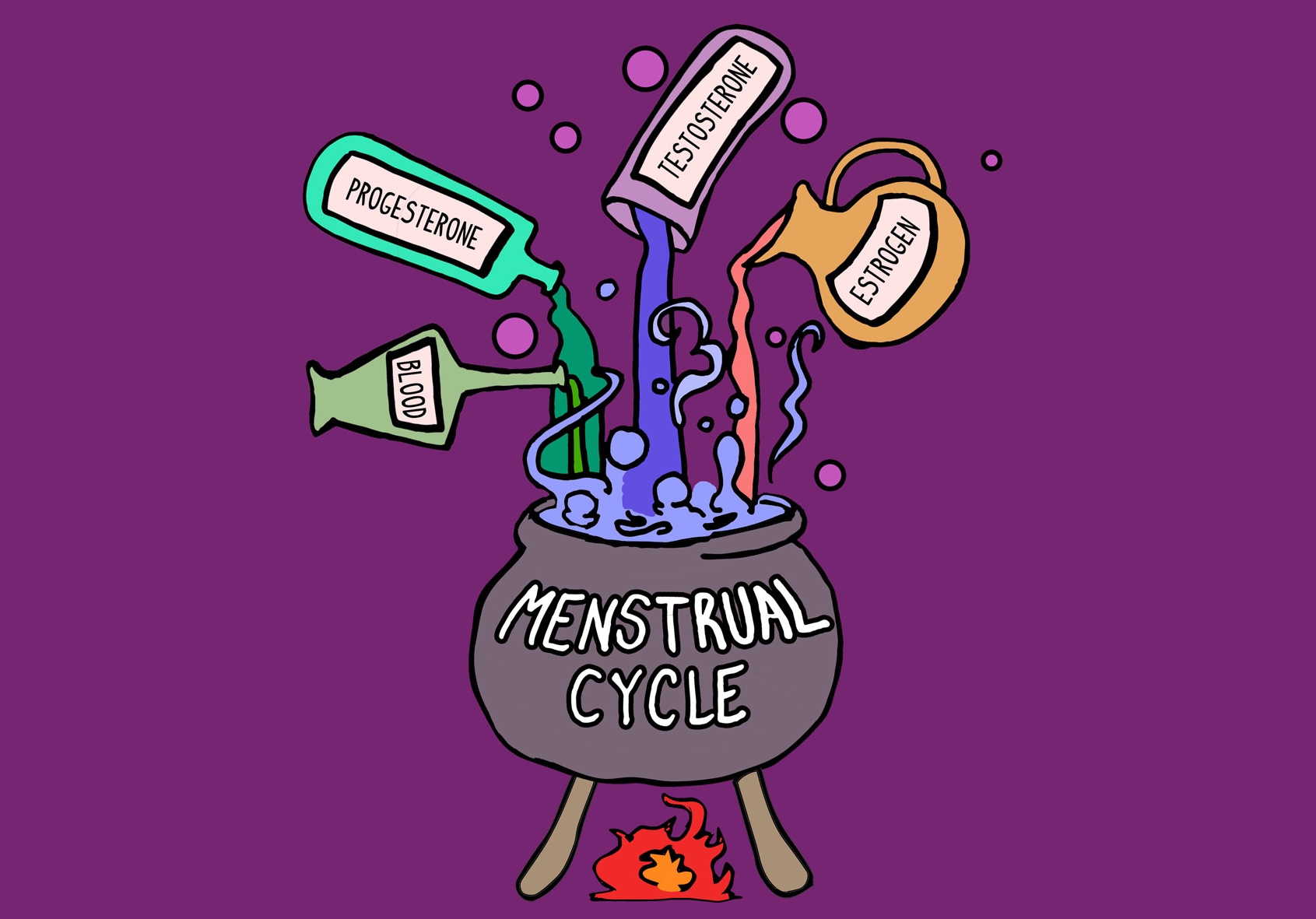Periods: Part One
author: Sunny rodgers
ILLUSTRATIONS BY ARI SAPERSTEIN
Mythology around menstruation integrates sacred rites spanning centuries and cultures. Egyptian pharaohs were believed to become divine by drinking the blood of Isis, while Celtic kings sought immortality by drinking the “red mead” of Mab, the fairy queen— both of which were thought to be menstrual blood.
Ancient Greek festivals for Spring relied on mixing menstrual blood into fields to increase the fertility of crops. According to Eleusinian folklore, women carried seeds soaked in menstrual blood and wrapped in cloth to the fields to ensure a bountiful harvest come Fall.
Facts
Menstruation is a monthly shedding of the uterus lining. Most menstrual periods last an average of 3 to 5 days. The first day of menstruation is the first day of your period and the menstrual cycle is the recurring menstruation process that happens approximately monthly. On the first day of a menstrual cycle estrogen and progesterone hormones are low, which triggers the body to make more to prepare for the possibility of pregnancy.
According to the Association of Reproductive Health Professionals, females have approximately 450 menstrual cycles in their lifetime.
A century ago women typically got their first period or “menarche,” around age 17. Today, many start their periods earlier in life, around age 13. Scientists believe this is due to modern environmental and diet changes.
Unless pregnant, most women between menarche to menopause have a monthly cycle. According to Ayurvedic medicine, we have seven layers of tissue - lymph, blood, muscle, fat, bone, nerves, and our reproductive tissues— which are nourished sequentially. This means our reproductive tissues are the last to receive nourishment. So, when a person experiences their period each month this means their reproductive tissues are fundamentally healthy, which should be a reason to celebrate and not something to dread as many of us do.
There are certain types of unique menses such as vicarious menstruation, in which uterine blood is discharged from other areas of the body during menstruation, such as the nostrils, eyes, and ears. Retrograde menstruation occurs when some of the menstrual flow heads backwards through the fallopian tubes and into the abdomen.
Endometriosis is characterized by an abnormal growth of cells outside of the uterus causing pelvic pain and other symptoms tend to worsen during menstruation. The Endometriosis Foundation of America has more information and resources available.
For transgendered people who may have periods, the Trans Student Educational Resources (TSER) organization provides information and support on their site. Cycles + Sex is another great resource for information and recommends gender-affirming period products here.
Global Cultural Beliefs & Myths
Across the world, an estimated 300 million people lack access to sanitary products.
Due to menstrual poverty, women in rural India are reduced to using sawdust, newspaper, dirty rags, sand and dried leaves because they cannot afford sanitary napkins. 70% of all reproductive diseases in India are caused by poor menstrual hygiene and 20% of girls drop out of school after reaching puberty because of the lack of available sanitary options. Even in the United States, over 24 million people cannot afford menstrual products. We will dive deeper into sanitary options and the Tampon Tax in Periods: Part 2.
Many global stigmas and taboos surround menstruation, affecting all aspects of a woman’s life, including her choice of career. In Japan, women are discouraged from becoming sushi chefs due to the widespread cultural belief that menstruation causes an imbalance in women’s taste. In India, female chefs cannot work in kitchens during their periods because it is believed they can pollute the food with their touch. Taiwan’s Gender Equality in Employment Act allows for up to three days of menstrual leave each year.
According to UNICEF, almost half of the girls in Iran consider menstruation to be a disease. In Bolivia, girls believe that disposing of their used sanitary pads with the rest of their trash will lead to cancer. In rural Nepal, girls are kept hidden in dark rooms during their periods in accordance with a chhaupaditradition that considers menstruation taboo. This in turn stunts the girls’ education by not allowing them to attend school during this period of isolation. Hindi women are not allowed to enter temples while menstruating.
How Can You Help?
Period.org is a global youth-run nonprofit that is actively providing menstrual hygiene and education, along with worldwide distribution of menstrual sanitation products.
We also suggest contacting local homeless and domestic violence shelters to donate menstrual products to those in need. Another way to share the love is to have a “period party” and invite your friends to bring tampons, sanitary napkins, chocolate and cramp medicine and make “gift bags” to donate. Who doesn’t need some support during that time of the month?
Cycles
The word menstrual comes from the Greek μήνας and the Latin mensis which means 'month'. The average menstrual cycle length is 29.5 days and the lunar cycle lasts 29.5 days. There are different evolutionary theories speculating why the human menstrual cycle length evolved to be so close to the lunar cycle in length. Stories and beliefs connecting the two are found in various cultures and mythologies.
Scientific research has found that the moon rules the flow of fluids and ocean tides. This seems to include monthly flow as well. According to a study in the medical journal Acta Obstetricia et Gynecologica Scandinavica tracking the menstrual cycles of 826 female volunteers in relation to lunar rhythm; nearly 30% had their period around the full moon. An additional Environmental Health Insights study found that the closer the moon was to the Earth more babies were born. So, there is scientific evidence that the moon amplifies fertility.
Prior to the prevalence of artificial light some scientists believed women ovulated when the moon was full and started menstruating when the moon was new. The time between the new moon and the full moon is the time when estrogen increases, culminating in ovulation when the moon is at its fullest.
In Native American cultures women separate themselves from their tribe and retreat to a moon lodge, a place where they can collectively tap into and celebrate their feminine energies and lunar energies.
Have you considered your menstrual cycle in relation to the moon cycle? Some of us menstruate on the crescent moon, some on the full moon, some on the waning moon, and others on the new moon. To track your menstruation to the moon cycle simply begin to observe how it relates to the moon—do you ovulate on the full moon and menstruate on the new moon? Or something different? Don’t judge. Simply observe how you feel during each cycle, physically, mentally, emotionally, and spiritually.
Take a Moon Phase Bath
Enjoying a salt bath during menstruation can help stabilize your body fluids and relieve bloating, as well as calm cramping symptoms.
Create Bath Salt Sole:
Sole is water that is fully saturated with unrefined natural salt, most often Himalayan Pink Salt. You can read more about the overall benefits of Sole here. However, you don’t need to use a pink salt if it is not readily available for you. We also like Epsom salts, magnesium flakes and in a pinch—a big box of table salt will do.
To make, place one cup of salt in a 1-liter mason jar and fill with ample warm water to fill the jar. Allow to sit for a minimum of three days, occasionally turning the jar to help the salt dissolve. If there is salt left in the bottom of the jar then the water has absorbed to its capacity.
Add the Bath Salt Sole to your bath during the following times and allow yourself to soak for at least 30 minutes to get the maximum benefits.
Full Moon Bath: this is when your body can absorb the most benefits from minerals.
New Moon Bath: this is when your body is naturally ready for detoxification.
Do Women’s Cycles Sync?
The McClintock Effect, a 1971 study by Martha McClintock, showed menstrual synchrony between women. Research by Rebecca Burch and Gordon Gallup of State University of New York at Oswego discovered people are more likely to experience synced menstrual cycles if they’ve been exposed to semen.
National Geographic found that female lions can also sync menstrual cycles.
Menstrual Tracking Apps
Discovered in 1960 in the Congo, the Ishango Bone is a 20,000-year-old mathematical tool. Among its’ supposed uses included keeping track of the menstrual cycle.
Today, our smartphones have made menstrual tracking apps available at our fingertips. Because menstrual bleeding can vary amongst individuals, having a personal period tracker can be extremely helpful.
As the case with all apps, there is a plethora of options available. I’m going to cover the ones that had the highest reviews among people I discussed this essay with. The Sex Ed would love to hear from you if you have a favorite menstrual tracking app that you use!
Clue came out on top time and time again amongst the people I polled. More than a mere smartphone app, Clue is a resource and research partner backed by Oxford, Stanford, and Columbia. Clue’s website is chock full of education and information about cycles, sex, STI’s, safe sex, and more. On Clue’s app you can log the length of your period, type of flow, favorite products, and PMS symptoms. Clue even allows for cervical fluid tracking to assist with ovulation and fertility. Another reason to love it? It’s free.
Eve gathered high points for their positive attempts to make your period fun. Eve also links with the Glow app which monitors sleep, weight, sex life, and overall gynecological health, making it an ultra-valuable personal resource. Eve’s horoscope-like “Cyclescope” and sex quizzes can be a blast but I feel that Eve’s all-encompassing functionality makes it a winner.
Flo was mentioned by several people I spoke with for one reason – it is password protected. Evidently there are still those of us who are actively hiding their periods. I found Flo to be health-conscious and very helpful with predicting irregular menstrual flows. Considering Flo raised over $5 million to invest in artificial intelligence to help their app analyze and predict flows, they should be considered a growing resource in this femtech market.
The FitrWoman app is geared towards athletes and their special needs. FitrWoman provides daily training and nutrition advice in addition the tracking menstrual cycles.
What’s Up Next in Periods—Part 2?
Intimate self-care for your cycle and a few ways to ease those period side effects.
As always, we want to hear from you!
Is there a particular topic you’d love to hear about? Our team is here to offer you education, information, and honest talk about all things sex ed.


